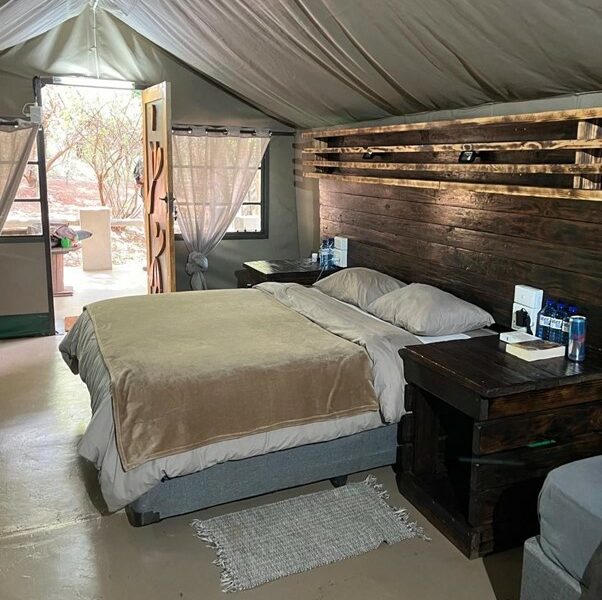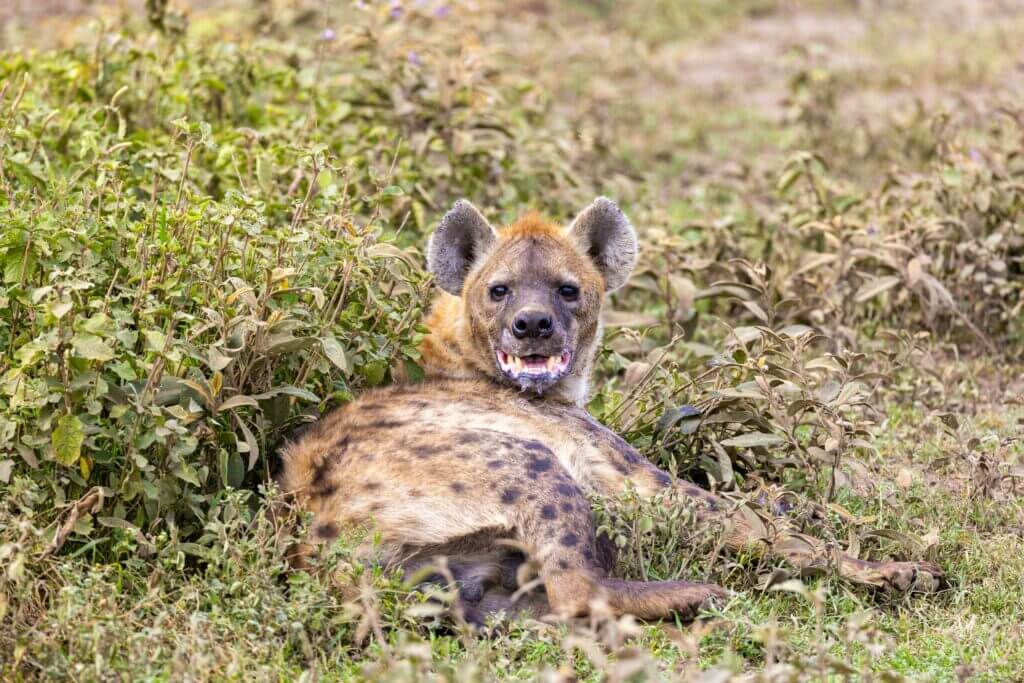This is Part 1 of a two-part blog, featuring our recent exciting hyena hunting experience in South Africa’s Limpopo province.
Read about the preparation, technology, shot placement, African outfitters, as well as other interesting facts, while Part 2 gives insight into our game hunting adventure: The long nights, the game that visited during the night, the ups, the downs, and the frequent call of the dying duiker over the FoxPro!
[DYNAMIC-BLOGTABLEOFCONTENT]
Hyena Hunting in Africa
Hyena hunting in Africa! How difficult could hunting some of these specialty game possibly be? Well, Tamlyn and I were about to find out the hard way. Sometimes Lady Luck is on your side, and sometimes she isn’t apparently…
Hyenas are definitely seen being more on the mysterious side of African wildlife, and, in general, not many people know too much about them. Firstly, contrary to popular belief, hyenas are not endangered. Hyenas are famous for traveling great distances and can average 10 to 20 miles in a single evening. They can be found on most ranches and concessions in Africa and are listed as “least concern” by CITES (Brown Hyena and Spotted Hyena). So, being plentiful, hyena hunting should be relatively easy, right? Wrong!
Our initial quest was to go spotted hyena hunting in the Limpopo Province South Africa. The spotted hyena hunting grounds we were heading to, are approximately 300 miles from Oliver Tambo International Airport. We chose to drive up and enjoy the scenery along the way. The trip by vehicle took approximately four hours on the national roads, with the nearest town being Louis Trichardt.
FAQs when Hyena Hunting
When do Hyenas Hunt?
Hyenas, while opportunistic predators, are nocturnal and do their best hunting under the cover of darkness, especially under the crescent moon.
How do Hyenas Hunts?
Hyenas are exceptional hunters and not only scavengers as often thought and believed. However, hyenas are opportunistic predators and will not hesitate to “steal a meal” like most other African predators.
Hyenas, if living in a clan, can hunt in packs but are more than capable of hunting on their own
What is the Best Caliber Rifle for Hyena Hunting in Africa?
The minimum recommended caliber for a hyena game hunting safari would be a .270, while a 7mm or any rifle in the 30 caliber such as a .308, or 30.06 will get the job done. A 300 Winchester Magnum is also a popular choice for hyena hunting in Africa.
What is the Best Shot Placement when Hyena Hunting?
When considering shot placement on a hyena, the hunter needs to bear in mind that the rifle will be fitted with night vision. A reminder that as the hyena is a nocturnal hunter, the African game hunting safari will take place at night. A headshot is most definitely to be avoided, as the hyena trophy will be ruined. The recommended shot to be considered will be the heart shot and the vital organs.
Where Will We Stay on a Hyena Hunting Safari?
Many African outfitters supply tented accommodations equipped with comfortable sleeping quarters, private bathrooms, and hot water gas showers.
Accommodation is cleaned, washing is done daily, and there are old cold beverages in the coolers.

Hyena Hunting Methods
Numerous methods may be used when hyena hunting, namely baiting and/or calling, or making use of both methods simultaneously. Hyenas do often get hunted when spotted purely by chance while on an African plains game hunting safari.
While stalking a trophy impala, a hyena may be spotted by chance during daylight hours out at 200 to 300 yards and BAM!!, the impala hunt has suddenly turned into a spotted or brown hyena hunting safari! However, just a little heads up before just squeezing the trigger, check with your African outfitters whether a hyena hunt is a possibility, based on the permit situation.
Baiting Hyena Hunting Method
Both the brown and spotted hyena (also known as the laughing hyena) can be hunted using bait, with the intention being to lure the hyena in. Hyenas will eat most animal carcasses, so one does not have to be exceptionally particular, as long as it emits a strong “dead carcass” kind of smell. The outfitter will prepare the chosen area with bait, build a blind, and will more than likely use a trail cam to monitor animal activity before the commencement of the hunting safari.
The problem with this method is that the hyena will not always “come in” every night, but maybe every second or third evening. Also, if there are spotted hyenas in the area, they will tend to “push out” the brown hyenas and drive them out of the territory.
Calling Hyena Hunting Method
In this instance, the outfitter will identify an area where there has been fresh hyena activity, in other words where there are hyena tracks, or in the case of spotted hyena, where a den may have been found.
A FoxPro, which is an electronic predator caller will be used. The FoxPro is loaded with electronic sounds that can be randomly changed while calling using a remote. The unit comes with standard pre-loaded sounds, but outfitter specializing in night critter hunting will also customize their own and see what works best for them. This will be done by downloading specific hyena or other animal distress sounds from various sources such as YouTube etc.
The FoxPro, depending on the model, can send these “call sounds” from up to two and a half miles away. The idea is then that the targeted night critter predator animal will “come in” to investigate the source of the sound.
A good rule of thumb to follow is that if the predator has not arrived after 40 minutes, abandon the area, and choose another site as the hyenas are not around at that time.
Interestingly enough, a spotted hyena, if in the vicinity will answer FoxPro with the famous “Whooooooop” sound, while a brown hyena will come in on the quiet.
Bait Dragging: An “Extra” Attraction while Hyena Hunting in Africa
A common practice when Hyena hunting is also to “drag” the area with intestines from the bait say two miles in each direction from the blind or FoxPro. Should a Hhyena traverse into the area, they may stumble across the smell of the carcass which will hopefully encourage them to follow the scent. A hyena has an excellent sense of smell and can detect a carcass at a distance of 1,5 to 2 miles away.

Some Sound Hyena Hunting Tips
- Get enough rest before the hunting safari as sleep may be minimal.
- Pack a few crates of Red Bull, you’re going to need it!
- Be prepared to possibly travel great distances daily to the hyena hunting grounds.
- Get used to using a night vision scope before the hunting safari, take a few “practice shots” in the dark if this is your first hunting safari using night vision.
- Pack appropriately. Hunting hyenas in the hours between 10h00 and 04h00 can get rather chilly, so be prepared.
- Check the lunar cycler when booking the game hunting safari, as hunting hyenas under a full moon is not recommended.
- Ensure that all electronic and digital equipment is fully charged daily with spare batteries where applicable.
An Interesting Hyena Fact to Consider when listening for this Predator
Did you know that hyenas are, in fact, double-jointed in the legs? What this means is that when they run, their paws tend to “slap” the ground making an audible noise. The hunter, while in total darkness, can thus clearly hear a hyena running into the hunting area.
Hyena Hunting and Technology
What Equipment will be used when Hunting Spotted and Brown Hyena?
Besides the obvious, a decent caliber rifle shooting high-quality expandable bullets, equipment for hyena hunting is extremely specialized. The hyena hunting safaris take place in the dark of the night, so:
- The rifle will need to be fitted with a high-quality night vision scope allowing the hunter to get a clear image of the predators entering the hunting grounds.
- These scopes can in fact, via Bluetooth be connected to an iPad or similar device. This will allow for the observer and professional hunter to view the same image as and when the hunter sees through it through the night vision scope.
- The hunter will need to be able to differentiate between jackals, hyenas, leopards, servals, and other nighttime critters while on the night hunting safari.
- The night vision scope will also need to be connected to a portable battery bank via a USB port for extended usage time.
- A high-quality scope will also have the facility to make use of a memory card being able to record the entire hunt. A good quality night vision scope will also be equipped with a range finder thus assisting the shooter in quantifying distance from the rifle to the target.
- A shooting chair, being silent, and being able to swing 360 degrees if shooting from a vehicle, will also be a standard requirement. A Hyena, answering a FoxPro caller can enter the hunting grounds from any direction and the hunter will need to be able to swivel, aim (remember your shot placement!), and shoot quickly before your target disappears into the darkness again.

- The professional hunter will make use of a thermal monocular for spotting predators. This device can also be linked to a cell phone which the hunter can then view on a smaller screen ensuring less light transmission. The hunter, while spotting, can then choose to view either the images directly through the night vision on the scope or view the cell phone to see what the professional hunter is spotting.
Important Considerations when Hyena Hunting Using Technology
- The view through a night vision scope is quite different than the view through a thermal monocular. With a thermal monocular, the professional will appear to eyes like “Superman” seeing straight through the thick scrub.
- So basically, just because the professional hunter has eyes on something using thermal, does not mean that the hunter will have the same view through night vision and may not be able to see the predator until it moves out from behind the area of cover.
And So the Hunt Begins...
So we were all set for the hunt, with all the required technology (check!), rifles (check!), and warm clothing (check!). Our hunt was just beginning, and the excitement of the event was running high.
See Hyena Hunting and the Unfavorable Scoreboard – Part 2 for the end to this challenging hyena hunting adventure!
Author: P.C. van Wyk
